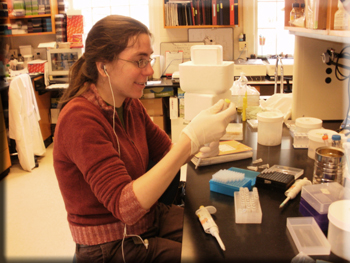
Research
We at the Jones lab are interested in the evolution and underlying genetics of species-specific adaptations. Although this knowledge is critical to biologists's understanding of phenotypic evolution, surprisingly little about the molecular basis of these complex traits has been uncovered. The Jones labs’s overall goal is to identify, clone and characterize genes involved in natural adaptations. Through this work we seek to determine the types of genes involved in adaptation, their abundance throughout the genome, the consequences of their expression, and the evolutionary history of their origin.
Our choice model organisms are members of the genus Drosophila and we utilize several different species in our projects. A few specific examples of the various projects now being conducted are...
- The genetic analyses of adaptation and interspecific genome differences between D. sechellia and its close relatives, D. simulans and D. melanogaster. D. sechellia is known for using the fruit of the morinda plant (Morinda citrifolia) as its particular host, feeding and laying eggs on its fallen, rotting pieces. This plant happens to be repulsive and ultimately toxic to D. sechellia’s relatives as well as all ot
 her species of arthropods tested thus far. Using a variety of NextGen Genomic, Quantitative Trait Locus (QTL) and genetic approaches, the Jones lab is currently analyzing traits involved in taste, food recognition and behavior to determine why D. sechellia has such a unique preference.
her species of arthropods tested thus far. Using a variety of NextGen Genomic, Quantitative Trait Locus (QTL) and genetic approaches, the Jones lab is currently analyzing traits involved in taste, food recognition and behavior to determine why D. sechellia has such a unique preference.
- Several genome sequencing projects involving various species of Drosophila as well as bacterial and viral genomes. A deeper understanding of sequence information has the potential to provide new insight into how genomes evolve. Areas of further research include which types of genes are evolving most rapidly, how new genes arise, and what the relationships are between recombination, DNA divergence and DNA polymorphism. We make special use of UNC's high-throughput DNA sequencing facilities to accelerate our results.
In the Jones lab, we are also interested in developing new methods relevant to the study of evolutionary genomics including theoretical, bioinformatic and statistical approaches. This particular research falls into three areas: (1) developing novel methods for assembling genomes using high-throughput DNA sequencing, (2) examining spatial patterns of DNA sequence evolution, and (3) detecting genetic changes due to natural selection.
Research areas
Adaptation: Our work will provide a uniquely in depth view of how a genetically complex behavior evolved and provide a springboard for further studies of adaptations involving host preference.
Novel Genes: Recent studies of ours and others have revealed the rapid evolution of new genes formed from non-coding sequence, not preexisting genes.
Population Genetics and Recombination: Fine-scale recombination rate variation analyses within and between Drosophila species.
Characterization and Differential Analysis of the mRNA Transcriptome: Capture of the mRNA transcriptome in the form of an expression-weighted splice graph (ESG) that represents the transcribed portions of the genome, their splicing structure, and the steady state level at which these transcribed regions are expressed.
Microbial Genomics: We are applying NextGeneration sequencing as part of several collaborative projects looking at how natural selection shapes genomic variation.

